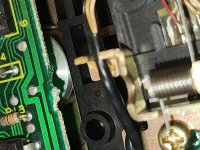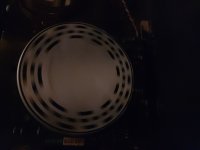Chuck(G)
25k Member
One has to wonder if the head is making consistent contact with the medium.
Yes, forcing the heads to go down without a diskette in, the heads press against each other. So, with a diskette, I'd have to assume they both make contact with the diskette.One has to wonder if the head is making consistent contact with the medium.
I'll answer everything in order.Ok, a few random thoughts.
Ok, so imagedisk is showing that it is reading a few sectors during the alignment test. That is good, that suggests most of the logic and mechanical stuff is working.
A consistent pattern of 2, 5, 8, and 9 is very odd.
The first thing I would do is try a couple of additional formatted disks and see if this pattern is the same for those. (did anyone mention yet not to use high density 1.2mb 5.25" disks?)
The alignment test should show you the track and head number that the sector it has found identifies itself as. Does this match the track and head you have selected?
As you step the head to different tracks, does this pattern remain consistent?
If you select the other head, is this pattern still the same and consistent?
You might check the spindle hub. Is it gripping the hub properly? As the disk spins, does everything seem centered? Is there any garbage stuck on the hub grip?
You might also try gently pressing down on the top head while it is reading. Does that change anything?
Does the disk seem to be spinning easily? I've seen odd behaviors when a disk is not in the drive flat - such as when a front bezel is crooked or something inside the drive is not quite where it should be and pressing against the disk.
You did say the drive completely failed to format, right?
No, it's direct drive. There are no belts.Too many posts down from the start, but this is a taut-band positioning system, right? Are you sure that nothing's slipping there?
The spindle motor is recessed into the housing of the drive, so it shouldn't have the ability to touch anything. It would also make an audible sound, since I've accidentally had it touch the top of the computer before.Still working on the assumption that the drive electronics are good. I would agree with @Chuck(G) that this is looking like a mechanical issue. I came here to recommend that you try to wiggle the head positioning motor to see if it is loose.
It seems you've been at this a while but have you tried doing the format/read back dance with the drive on its side so that nothing is touching the spindle motor.
Sorry, I should have included the fact that I made DOS diskette from a .IMD file, which Windows was able to read just fine last night. ImageDisk is also unable to read the DOS disk now, displaying all "?" again.Wait, you were using Imagedisk to write a format? I don't believe that will write a file system (I think), so it won't be readable in DOS.
Normal DOS disks use an interleave of 1. So the sectors are ordered 1-9. With the sector order you describe, it suddenly makes sense if part of the track is getting overwritten. For example, if you have the wrong sector size, data rate, or gap size selected, that can happen.
It's either that or a drive speed issue. If you can get it to a working point for a moment, focus on using Imagedisk to measure the drive speed.
It sounds to me like the drive may be working fine but there is something wrong with the controller or system - which is why I strongly encouraged sanity testing with a 3.5" drive.
You might try a couple of other disk formatters and see what they report. Perhaps NFORMAT and FormatQM.
Sure, you have the stepper positioner attached to a capstan (in the nautical sense). A thin steel fork-shaped band is wrapped around the capstan and secured in the middle to the capstan. The free ends of the band attach to the head carriage. You can see that, as the stepper rotates the capstan, the rotary motion is translated to a linear motion. Here's the seminal patent: https://www.freepatentsonline.com/4992899.pdfNo, it's direct drive. There are no belts.
Edit: Idk why I thought you were talking about the spindle motor. I don't know what you mean by taut-band positioning system. Could you please explain?
Wait, you were using Imagedisk to write a format? I don't believe that will write a file system (I think), so it won't be readable in DOS.
Normal DOS disks use an interleave of 1. So the sectors are ordered 1-9. With the sector order you describe, it suddenly makes sense if part of the track is getting overwritten. For example, if you have the wrong sector size, data rate, or gap size selected, that can happen.
It's either that or a drive speed issue. If you can get it to a working point for a moment, focus on using Imagedisk to measure the drive speed.
It sounds to me like the drive may be working fine but there is something wrong with the controller or system - which is why I strongly encouraged sanity testing with a 3.5" drive.
You might try a couple of other disk formatters and see what they report. Perhaps NFORMAT and FormatQM.
It would appear that it's as you described. I included some pictures, but they're not very clear. I can't get a good image with it under the circuit board like that.Sure, you have the stepper positioner attached to a capstan (in the nautical sense). A thin steel fork-shaped band is wrapped around the capstan and secured in the middle to the capstan. The free ends of the band attach to the head carriage. You can see that, as the stepper rotates the capstan, the rotary motion is translated to a linear motion. Here's the seminal patent: https://www.freepatentsonline.com/4992899.pdf


Putting the drive on it's side, the results are the same. It still won't read the correctly formatted disk. Reformatting it brings us back to the 4 sector problem. It will still only read the last 4 sectors. I formatted it as 1:1 interleave, so it's reading 6, 7, 8, and 9 as the only sectors this time.Still working on the assumption that the drive electronics are good. I would agree with @Chuck(G) that this is looking like a mechanical issue. I came here to recommend that you try to wiggle the head positioning motor to see if it is loose.
It seems you've been at this a while but have you tried doing the format/read back dance with the drive on its side so that nothing is touching the spindle motor.
You did verify the spindle speed as 300 RPM, correct?
I'll have to purchase a printer or something, because the FDD doesn't come with a strobe disc on it. I tried drawing a mark with a sharpie, but that was rather ineffective.
Go to your local kinko's/mailboxes etc./print shop and make a few, because wrong spindle speed is the only thing left that points to what is going on.I'll have to purchase a printer or something, because the FDD doesn't come with a strobe disc on it. I tried drawing a mark with a sharpie, but that was rather ineffective.


